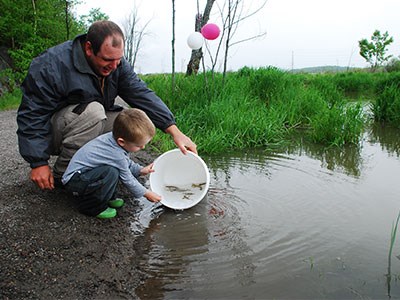It’s been 15 years since a small group of volunteers decided to take on the rehabilitation of Sudbury’s Junction Creek. What started as a grassroots effort has resulted in a unique partnership with one of the world’s biggest mining companies.
Vale has been one of the Junction Creek Stewardship Committee’s most reliable and consistent industry partners since its inception in 1999, said Sarah Woods, the committee’s research manager and coordinator. The company has contributed both with financing and labour to rehabilitation efforts.
“We’ve had a (Vale) member on our board for a very long time, so they’ve been helpful not only with the financial and logistical components, but also as a source of information and expertise for the committee, which has been incredibly valuable,” Woods said.
Vale conducts the analysis of monthly water samples taken by the committee, while employees take part in annual creek cleanups.
Though much of what the committee does is hard to measure, fish studies conducted with the Co-operative Freshwater Ecology Unit in 2004 and 2008 show improved fish communities, which results from better water quality, Woods said.
“We found improvements in species richness (number of species) and distribution within the watershed, so it looks like even in that small span, fish are able to colonize new areas, and we interpret that as being an increase in habitat quality,” she said.
Areas that formerly had no fish now are home to eight to 10 species, and last year marked the discovery of the Blanding’s turtle in the creek, which has threatened status on the province’s Species at Risk list.
For the company, the information is valuable when it comes to making decisions about operations, reclamation planning and permitting processes, said Allison Merla, a senior analyst with the environment division of Vale’s Sudbury operations.
Vale, which has three water plants that discharge into the creek, along with several operations close to the waterway, relies on the database of information to identify species present in certain areas of the creek, along with what the habitats look like, she said.
“If we’re looking for particular information on what’s a sensitive receiver, or have there been any changes in the creek over time, it’s an invaluable resource to know that the stewardship has been out there collecting that data and we can pull it in,” Merla said.
Simple habitat restoration projects, like bundling willows to help build out the shoreline, provide the fish with better shelter and refuge and protect the creek, which is indirectly helpful.
“It’s overall going to improve the creek and that helps the species that are there,” Merla said. “And that helps the mining industry in terms of tracking temporal changes.”
Data also helps the company’s mandate for community engagement, which is a large part of Vale’s environmental effects monitoring program, she added. The relationship has never been an antagonistic one—the environmental group taking on the ‘big, bad mining company’—but one of open communication and the sharing of resources and information.
“It’s a back-and-forth where we feel comfortable going to the committee, sharing our results, sharing what’s going on in the operations, and letting them help us as well,” Merla said.
Over the next five years, the committee will focus on increasing the number of tree species along the creek, along with research into where species at risk are in the watershed and the types of habitats that are most important to them. The committee will also incorporate an art component into the creek.
“It’s a pretty grand plan, but the key components are research, restoration and public involvement,” said Shannon Dennie, the committee’s coordinator.
Merla predicted the company will see a further drop in emissions with the implementation of Vale’s Clean AER project, and the resulting data could help paint a clearer picture of what effects in the creek can be directly attributed to mining operations.
“We see the relationship that has built up between the committee and the mining company as a really good example of how working together makes a difference, how that relationship and that strategy has seen improvements in the restoration of the creek, and looking to use that almost as a model for other relationships, whether they be in Sudbury or elsewhere in the country or abroad,” she said.




